●Date: 18-21 July, 2017
●Venue: Massachusetts Institute of Technology, Industrial Liaison Office,
etc. |
(Up&Coming 2017 Fall issue) |
| Ten-year anniversary of World16 |
|
|
"World16", the workshop with the aim of practical application of 3D digital technologies such as UC-win/Road, marks 10 years in 2017 since it was established by worldwide researchers in the field of architecture, construction, and city. It started from the "World8" consisted of eight members in the fall of 2007, and now has become the World16 with 16 members.
From 18th to 21st July, International VR Symposium, The 8th Summer Workshop
in Boston was held in MIT: Massachusetts Institute of Technology in Boston,
US (Fig.1). The VR Summer Workshop is a hackathon that the members of World16
work on with FORUM8 members towards presentations at the International
VR Symposium in Tokyo planned in November of the year.
So far, the summer workshop has been held mainly in bases of World16 members
such as in Phoenix, the US (2008), Hakone, Japan (2009), Santa Barbara,
the US (2010), Pisa, Italy (2011), Hawaii (2014), and Thessaloniki, Greece
(2015), and Osaka (2016). This year, the MIT in Boston, the activity base
of one of the member Kostas Terzidis (Harvard University / US), was chosen
as the venue. During the summer workshop, we had the selection meeting
of the CPWC (The 5th Cloud Programming World Cup) and the TV recording
for "Get together! VR friends with Pakkun & Mayuko Kawakita: Summer
Special Program in USA" by Tokyo MX, and about 40 people including
TV crews gathered from seven countries.
|
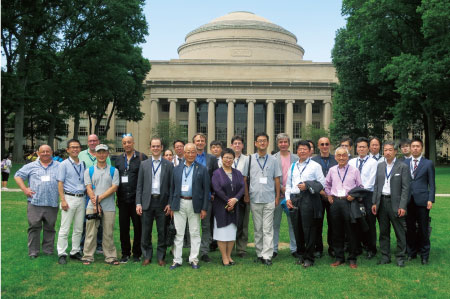 |
|
| 1. Summer workshop group photo at the MIT's Great Dome |
2. Boston (upper) 3. Green Line (center)
4. Freedom Trail (lower) |
| Boston |
|
|
Boston is a historical city deeply involved in the American foundation
such as the Boston Massacre (1770), the Boston Tea Party (1773), and the
United States Declaration of Independence at the Old State House (1776)
(Fig.2). Also, a lot of facilities were built in Boston as the first building
in US: park (Boston Common, 1634), university (Harvard University, 1636),
botanical garden (Boston Public Garden, 1837), public library (The Boston
Public Library, 1848), and subway (Green Line, 1897). These days, urban
redevelopments such as the Faneuil Hall Market Place and the Big Dig Project
are progressed. The former is a preservation and utilization of historic
buildings at Waterfront, and the latter is a project with a purpose of
resolving the division of cities and creating public space on the ground
by embedding highways under ground. Boston and adjacent Cambridge are the
world's leading academic cities where traditional universities including
Harvard University and MIT are located.
Mr. Tomohiro Fukuda entered Boston via Istanbul that he visited to attend
the CAAD Futures 2017 International Conference held in the previous week.
The followings are the introduction of Boston that he visited little earlier
than other members.
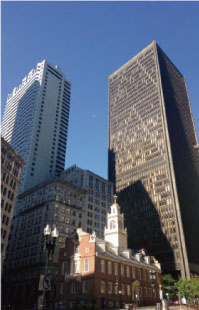 |
|
|
|
| 5. Old State House |
6. Old North Church (upper left) 7. Big oyster signboard (upper center)
8. Inner Harbour (upper right) 10. Inner garden of the public library (bottom left)
11. Back street in Back Bay district (lower center)
12. Brick building and emergency stairs (bottom right) |
Mr. Fukuda boarded the America's first subway Green Line from his accommodation
to Boston Common. A normal subway is built as an urban high-speed railway
that quickly transports a large number of people in a metropolitan area,
but this Green Line is a subway made in the center of the city with the
purpose of operating a through tram (Fig.3). Thus, while being a metro,
its platform is at the almost same height as railway tracks, and a two-car
tram rumbles to there. Like attractions in amusement park, the train moves
much slower than a normal subway through a sharply curved tunnel along
the road. He got off the metro at the Park Street station and walked along
the Freedom Trail from the Boston Common (Fig.4).
The Freedom Trail is a 4.0-km-long path from the Boston Common to the Bunker
Hill Monument in Charlestown, connecting 16 locations significant to the
history of the US foundation such as the Old State House (Fig.5), the Faneuil
Hall, and the Old North Church (Fig.6). This trail course was created in
1951 and has a long history. The course is connected by red brick lines
so that walkers have no worries to get lost without reading a map. On the
way, in a line of nice buildings made of bricks and stones, there was an
oyster signboard similar to ones seen in Osaka (Fig.7). He took a water
shuttle to go back to the center of the city from the Bunker Hill, the
goal of the Freedom Trail (Fig.8). The shuttle was comfortable since the
city center and waterside are nearby.
|
|
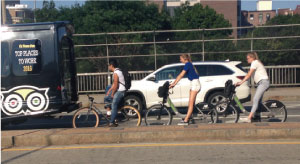 |
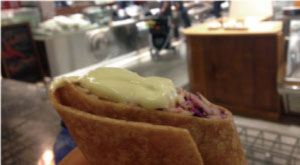 |
9. Commute by community rental cycle (upper)
13. Boston Public Market (lower) |
|
| He found some other sceneries in Boston: commuting by community rental cycle (Fig.9), CG-like sunlight coming in the inner garden of the public library (Fig.10), the back street in the Back Bay area where expensive stores are gathering (Fig.11), emergency stairs of steel frame equipped to typical Boston buildings (Fig.12), and the Boston Public Market that consists of local farmers and fish stores and has an eating space (Fig.13). |
|
| DAY1 |
|
|
The workshop kicked off with an opening session. Mr. Yuji Ito, the CEO
of Forum8, Mr. Karl Koster, the Executive Director of the MIT ILP, and
Mr. Keiji Yano, the Associate Director of the MIT ILP, gave welcome speeches
(Fig.14). Following it, five Forum8 members who received the in-house award
and got the ticket to Boston were introduced in the Forum8 Award Session.
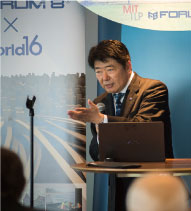 |
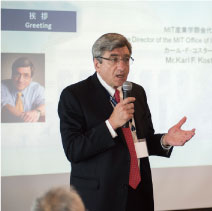 |
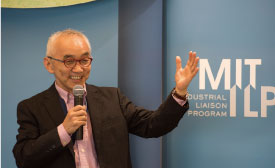 |
14. Welcome speech: (from left) Mr. Yuji Ito,
Mr. Karl Koster, Mr. Keiji Yano |
The World16 session was moderated by Mr. Yoshihiro Kobayashi (Arizona State
University, US), and 11 members of the World16 participated this time talked
about their recent study results and made proposals to tackle at this summer
workshop (Fig.15). After their power point presentations, a piece of drawing
paper was distributed to each member, and they wrote more detailed proposals
on the project they would like to work on in the summer workshop (Fig.16).
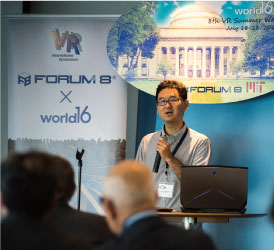 |
 |
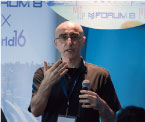 |
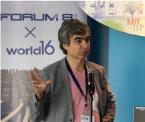 |
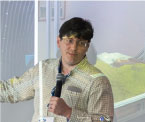 |
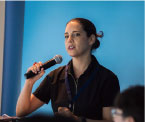 |
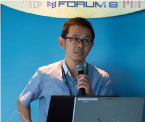 |
15. Presentation by World16: (left) Mr. Yoshihiro Kobayashi, Director of W16,
(from upper left) Mr. Thomas, Mr. Marcos, Mr. Kostas
(from lower left) Mr. Matthew, Ms. Ruth, Mr. Fukuda |
After having lunch in the restaurant in the MIT campus, the members had
a tour around the MIT campus as a light exercise. The new school building
that Mr. Fumihiko Maki designed and the MIT Media Lab is located inside
was covered with a lot of transparent glass. There is a unique model of
the building donated by the LEGO company (Fig.17). Inside the Stata Center
that was designed by Frank Gehry, a police car that was placed on the roof
of the MIT's symbol Great Dome in one night was exhibited (Fig.18). It
was a fuss at that time but revealed that it was a mischief by MIT students
with full of playfulness, and the patrol car was just a real scale model.
The members arrived at the Great Dome. Since it was during a summer vacation,
high school students including from Asian countries were visiting the campus.
Walking along the Charles river (Fig.19), the workshop members went back
to the meeting room and restarted the workshop.
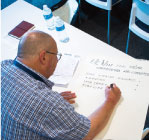 |
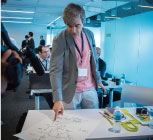 |
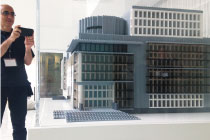 |
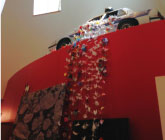 |
| 16. Creating project proposal material |
17. A model of the MIT Media Lab. |
18. Elaborate police car model |
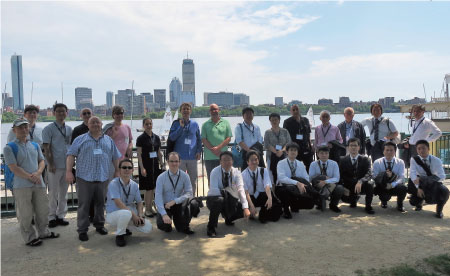 |
| 19. Group photo shot by the Charles River |
Contents of development that the members created before the lunch were
tacked on the wall and each idea was explained. Other members and Forum8
development staff brushed it up by asking questions and adding ideas. It
was what is called an ideathon (Fig.20). Finally, the members were divided
into seven teams after considering proposals with the same theme.
Mr. Thomas Tucker & Mr. Dongsoo Choi (Virginia Polytechnic Institute
and State University, US)
Mr. Marcos Novak (University of California, Santa Barbara, US) x Mr. Tomohiro
Fukuda
Mr. Kostas Terzidis x Mr. Amar Bennadji (Robert Gordon University, UK)
Mr. Matthew Swarts (Georgia Institute of Technology, US) x Mr. Marc Aurel
Schnabel (Victoria University of Wellington, New Zea land)
Mr. Paolo Fiamma (Universita di Pisa, Italy) x Ms. Ruth Ron (Shenkar College
of Engineering and Design, Israel)
Mr. Wael Abdelhameed (University of Bahrain, Bahrain)
|
| DAY2 |
|
|
Each team created on DAY1 began to work on each project (hackathon). While
some teams was keeping debating, other teams quickly started developing.
The members had a catering lunch at the workshop site to keep their concentration
(Fig.22). They also went out to the foyer and saw yachts and boats floating
on the Charles River to relax when the work was finished to some extent
(Fig.23). Ms. Ayaka Ikezawa who is a TV personality and a programmer showed
up suddenly. She brought relaxed atmosphere as well as a surprise to all
members, and joined the VR project as a system developer.
The next day is the final day, and the members must present their own work
result on the evening. They continued their work at night even after returning
to the hotel (Fig.24).
|
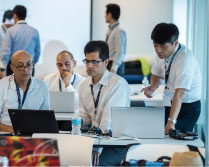 |
|
 |
| 21. Hackathon |
|
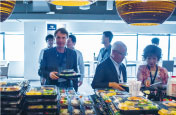 |
 |
22. Catering lunch (upper)
23. The Charles River seen
from the workshop site |
|
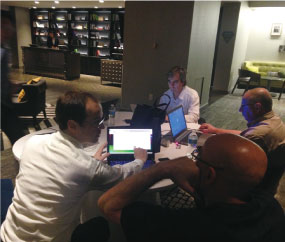 |
| 24. Workshop in hotel |
|
|
| DAY3 |
|
In the afternoon, a guest lecture session was held, and MIT researchers
delivered lectures below (Fig.25).
-Prof. Takako Aikawa, Mr. Christian Vazquez: Language Learning Application
with VR
-Mr. Greg Demchak: Applications of AR/MR on BIM
-Prof. Emilio Frazzoli: Transportation (Developments at an autonomous driving
company nuTonomy)
|
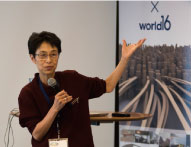 |
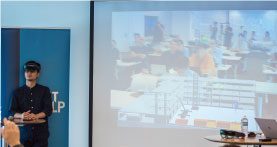 |
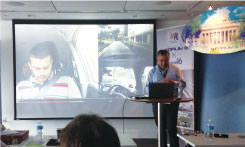 |
| 25. Guest lecture session |
|
In the evening, all the workshop members moved to the Kostas house in a
suburb of Boston (Fig.26) and did the final presentations. The results
are shown below in the order of presentation (Fig.27).
-Thomas Tucker & Dongsoo Choi: constructed a workflow to acquire 3D point cloud data of the MIT Liaison
Office in real time by using 360 degree LiDAR scanner, display the data
in mesh, and input it to a VR environment.
-Marcos Novak x Tomohiro Fukuda: developed a shader program that use the different renderings according
to a purpose such as hiding unnecessary elements from normal RGB rendering
and a segmentation program that divides objects into segment to show VR
city structure effectively.
-Kostas Terzidis x Amar Bennadji: took in a technique of storytelling into VR. When a viewer reaches a certain
point in the VR environment, the best information for the place will be
announced. They also proposed a system to edit colors of 3D models in VR.
|
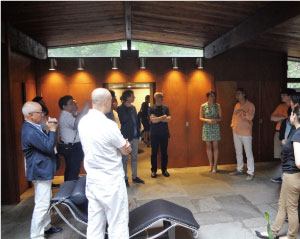 |
| 26. Kostas house |
|
-Matthew Swarts x Marc Aurel Schnabel: developed a plug-in that enables the collaboration of VR and external
tools developed by JavaScript with the purpose of constructing and using
VR in more open participatory environment. This enables VR block game,
interactive operation of objects via smartphone, and immersive / participatory
VR experience on hemisphere screen.
-Paolo Fiamma x Ruth Ron: developed a system that dynamically shows building data and construction
process that have not been much visualized so far by using a micro simulation
player. They demonstrated an automatic generation of time history animation
of the construction process with heavy machines and the shift of wall temperature
map obtained by infrared thermographic camera.
-Wael Abdelhameed: developed and proposed a system that display antiquity city model in chronological
order by using a micro simulation player. a project is in progress that
actual Mideastern ruins city models are created and its castle wall and
architectures of each era can be observed.
-Ayaka Ikezawa: constructed a system connecting VR and hardware (warning light and speaker).
If a vehicle goes out the road, the warning light rings and informs the
driver of it.
It goes without saying that the party at the Kostas home was successful
after the final presentation was finished.
|
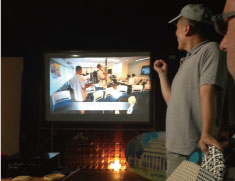 |
 |
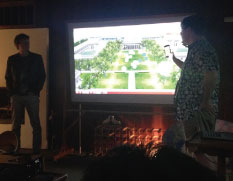 |
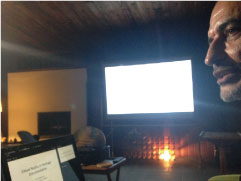 |
| 27. World16 final presentation |
| DAY4 |
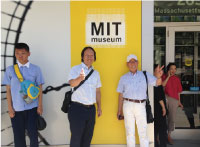 |
 |
28. MIT museum (upper)
31. Harvard University (lower) |
|
|
|
We made an excursion by bus since morning. The development history of robot
and hologram was interesting in the MIT museum (Fig.28). In the Harvard
University, Mr. Kostas Terzidis and Ms. Hyejin Lee who were familiar with
it gave us a campus tour (Fig.29). The only building designed by Le Corbusier
in the US (Carpenter Center for the Visual Arts), the Harvard Art Museums
designed by Renzo Piano, and The Harvard Graduate School of Design were
also curious (Fig.30). We also visited the Isabella Stewart Gardner Museum
and the Skywalk.
The Academic Encouragement Prize was presented at the last dinner in Boston.
Mr. Marcos Novak x Mr. Tomohiro Fukuda, Mr. Matthew Swarts x Mr. Marc Aurel
Schnabel, Mr. Kostas Terzidis x Mr. Amar Bennadji, and Ms. Ruth Ron x Mr.
Paolo Fiamma received the award (Fig.31).
At this 8th summer workshop, we worked on the team hackathon for the first
time. This method seemed to have improved the members' motivation and secured
the quality of development.
Each project proposed by the World16 will be presented at the 10th International
VR Symposium to be held at Shinagawa Intercity Hall on 16 November. We
are looking forward to having you attend.
|
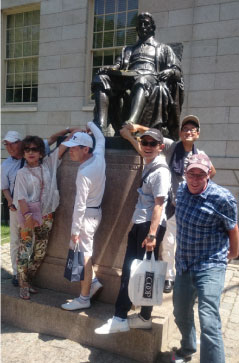 |
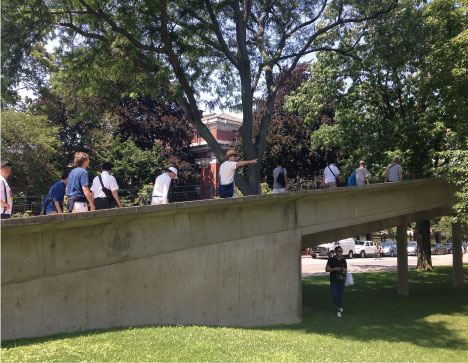 |
| 29. Harvard University |
30. Carpenter Center for the Visual Arts at Harvard University |
|
|